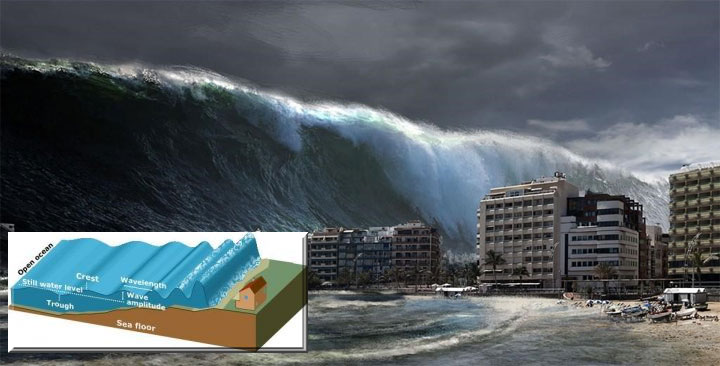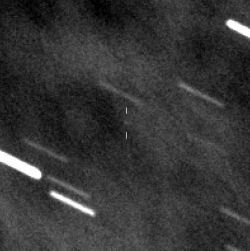


This article is based on one we published fifteen years ago on our web page.
On Sunday, December 26, 2004 at 7:58:53 a.m. local time the fourth largest earthquake in the world since 1900 occurred off the west coast of northern Sumatra. The resulting tsunami caused more casualties than any other in recorded history, killing more than a quarter of a million people.

This is what a mega-tsunami could look like | image CSU Geology Department
Some time after the disaster had struck we published a report on it, not the least because many of our readers requested we do so, despite the absence of a direct chess link. One early letter which stood out was from John Nunn, mathematician, grandmaster, chess publisher, who is very knowledgeable on any subject connected with science in general. John wrote:
"I think this whole Indian Ocean Tsunami disaster demonstrates how badly people assess risks involving rare but catastrophic events. There is a consistent error in such assessments: risks involving human agencies are regularly over-estimated, while risks involving natural agencies are regularly under-estimated. Thus the following risks are over-estimated:
- Terrorism
- Nuclear power stations
- Genetically modfied food
The following risks are under-estimated
- Volcanic eruptions
- Earthquakes
- Asteroid impacts
- Epidemics
It is depressing to consider the vast amounts spent on anti-terrorism measures (including the Iraq war), many of them quite pointless, while a few million dollars would have provided a tsunami warning system which would probably have saved a huge number of lives."
So will the world as we know it end on Garry Kasparov's 66th birthday? This question is not as flippant as it looks. In fact for a few days at the end of 2004 it looked like a very distinct possibility that the asteroid could impact Earth on that day. According to NASA it would strike with an energy of about 1400 megatons of TNT, 25 times more than the largest thermo-nuclear bomb ever tested and about 100 times more powerful than the Tunguska explosion over Siberia in 1908.

2004 MN4 is the unimaginative name given to a large rock – or small asteroid – that is moving in Earth-crossing orbit. It is estimated to be 400 meters (1300 feet) in length and to have a mass of around one million metric tons. 2004 MN4 was discovered in June 2004 by astronomers at the Kitt Peak National Observatory in Arizona. They observed it for two nights. The object was rediscovered on December 18 in Australia, after which first calculations of a possible Earth impact could be made.
On December 24 NASA published an impact chance figure of "around 1 in 62" (or 1.6%), the highest probability for any asteroid ever observed. In the course of a week NASA corrected the estimate on the basis of more observations to 1 in 37 or 2.7%.
Subsequently the asteroid was precovered (discovered on older photographs). In addition, NASA has just finished conducting radar measurements with the Arecibo radio telescope in Puerto Rico. The result of the new calculations is a zero percent chance of Earth impact.

Possible flybyes of 2004 MN4 on April 13, 2029
2004 MN4 will pass the earth at a distance of 36,350 km (or 22,600 miles), which is closer to the planet than geosynchronous satellites that relay TV and communication signals. The flyby will occur on April 13, 2029, which coincidentally is a Friday (paraskavedekatriaphobes can find relief here) and, even more ominously, Garry Kasparov's 66th birthday! [When we told him about NASA's latest findings Garry expressed relief: "Thank heavens. You know that people would have blamed it on me!"]
On April 13 2029 the rock will be easily visible to the naked eye, having a magnitude of 3.3. You will be able to see it at around 11 p.m. in Europe, moving past the constellation of Gemini moving at a rate of 42° per hour, which is less than half as fast as the International Space Station moves across the sky.
It should be noted that all impact estimates rely on a complete knowledge of the inner solar system and all the interactions that 2004 MN4 will have from now until the year 2029. Unfortunately our knowledge of the inner solar system is far from complete, and even a tiny change in the path of the rock, due for instance to an encounter with an unknown object will produce a substantial variation in the final earth-crossing position.
Currently there are around 1000 known asteroids larger than one kilometer with earth-crossing orbits. These are being tracked by NASA's Near Earth Object Program. None is considered potentially hazardous to earth in the near future.
In the follow-up to the original fairly dire risk calculations published by NASA, John Nunn retracted "asteroid impacts" from his list of humanity-threatening natural disasters. "Thinking about it a bit more, I don't think there is much danger from an asteroid impact. I had thought about the 1908 Tunguska impact, equivalent to perhaps a 10-megaton hydrogen bomb. Assuming one impact a century, this sounds quite dangerous. But if you assume that the impact kills everyone in an area of a thousand square kilometres, then, with surface area of Earth = 500 million square kilometres, that would be about 12 people per square km. Thus the impact kills 12,000 people or 120 per year. Thus it isn't much of a danger at all, compared for instance to epidemics, which are far more of a danger than the others."
Prophetic words, John.